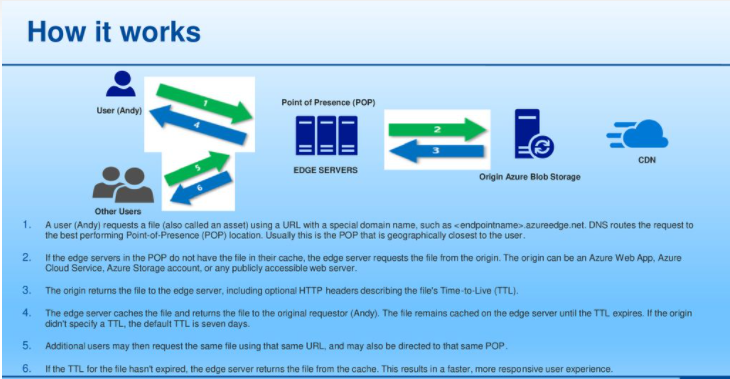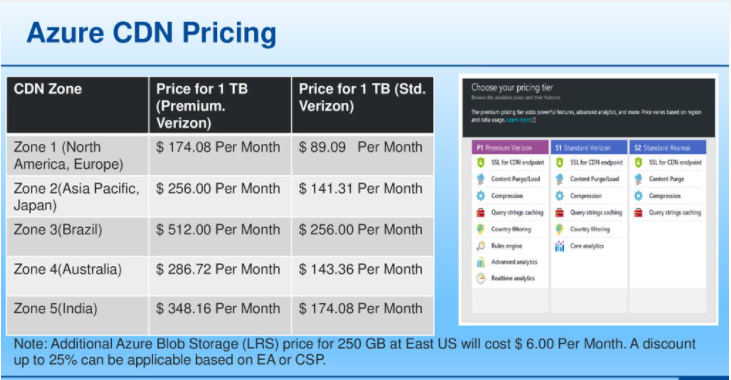
Hi guys, do you all know what Azure CDN is and its assets? So let us learn about Azure CDN and its assets. But before discussing these topics we should first know about Azure and also what CDNs are!
The Microsoft Azure, previously known as Windows Azure, is Microsoft’s civic cloud computing platform. It offers a variety of cloud services, including compute, analytics, storage and networking. The Users can take and choose from these services to develop and measure new applications, or run current applications in the civic cloud.
The Azure policy targets to help businesses manage tests and meet their structural goals. It offers tools that support all industries that include e-commerce, finance and a diversity of Fortune 500 companies and is well-matched with free technologies. This offers users the litheness to use their preferred tools and technologies. In a count, Azure offers four different forms of cloud computing infrastructure as a service (IaaS), platform as a service (PaaS), software as a service (SaaS) and server less.
The Microsoft prices for Azure on a pay to pay basis, it means that subscribers receive a bill each month that only charges them for the specific resources they have used.
About CDN:-
The content delivery network (CDN) refers to a physically divided group of servers which work collected to provide fast delivery of Internet content.
The CDN lets for the fast transmission of assets wanted for loading Internet content including HTML pages, JavaScript files, stylesheets, images, and videos. The admiration of CDN services continues to grow, and today the popularity of web traffic is served through CDNs, that includes traffic from major sites like Facebook, Netflix, and Amazon.
Azure CDN:-
The content delivery network (CDN) is a spread network of servers that can workwise bring web content to users. The CDNs’ stock cached content on verge servers in point of presence (POP) locations that are near to end users, to reduce dormancy.
The Azure Content Delivery Network (CDN) proposes developers a world-wide solution for quickly taking high-bandwidth content to users by hiding their content at deliberately placed physical nodes across the world. The Azure CDN can also fast-track lively content, which cannot be hid, by leveraging numerous network optimizations using CDN POPs. For example, the way optimization to side-step Superiority Gateway Protocol.
How does an Azure CDN work?

Over the entire internet’s traffic is served by a content delivery network (CDN). The goal of the CDN is to decrease dormancy, the interruption between succumbing a request for a web page and the web page fully packing on your device, by plummeting the bodily distance that the request has to portable.
For example, a US visitor wanting to view content which is created at a UK-based server will know poor loading times if this request has to travel across the Atlantic.
To battle this, CDNs store a cached type of your website content in manifold geographical locations around the world, which are recognised as “points of presence” (Pops). These Pops will cover their own hiding servers and will be answerable for bringing that content to the user’s site.
The agents, which are fundamentally devices running web browsers, make needs for content needed to render web pages such as HTML, images, CSS, and JavaScript files. For most CDNs, each request for content will cause the end user to be charted to an optimally-located CDN server and the server will reply with the cached version of the requested files. If it nose-dives to locate the files, it will look for the content on the other servers in the CDN platform and send the reply to the end user. Though, when content is unobtainable or decayed, the CDN will act as a request substitution to the origin server and store the made content to serve upcoming requests.

Benefits of Azure CDNs:-
The benefits of Azure CDNs are given below:-
- The Healthier performance for your apps and services.
- Global distributed network.
- Highly scalable infrastructure.
- Active redundancy and failover.
- High reliability.
- Robust security.
What are the advantages and disadvantages of Azure CDN?
The Use of a content delivery network transports both pros and cons and we want to take an earlier look at both in this object. By hiding data in the copy servers’ cache, CDNs allow for smaller load times, which is significant for both user fulfilment and SEO.
Advantage of Azure CDN:-
- Better performance and improved user experience.
- Decrease the load on Original server because files are delivered from the edge server (CDN).
- Only configuration required to enable the feature.
- Robust and less maintenance.
- Easy to configure and from resource only.
Disadvantage of Azure CDN:-
- You essentially have to spend around $0.10 per GB. It does not seem much but likening it with your regular hosting plan bandwidth, it is too costly.
- Storing some subtle files on the CDN network may open possible security susceptibilities. As, it does not matter what you store at CDN, it will be copied to all dispersed servers.
- Using the CDN, you are producing additional “points of failure”. If the CDN network goes down you may misplace website discernibility
Prioritise speed for the best experience:-
In operational content delivery, the user’s knowledge is everything. Azure Content Delivery Network (CDN) lets you cut load times, save bandwidth and speed receptivity whether you are developing or handling websites or mobile apps or instruction and assigning graceful media, gaming software, firmware updates or IoT endpoints.
- Global coverage and massive scalability.
- Integrated into your Azure services, letting you scale in minutes.
- Simple setup and no commitment: pay-as-you-go.
Conclusion:-
So far we have discussed Azure CDN, CDN and their following assets. Moreover we have also discussed their workings, priorities and its benefits. The Azure CDN is a content delivery network (CDN) which is a spread network of servers that can professionally deliver web content to users. The CDNs’ store hidden content on edge servers in locations that are close to end users, to lessen dormancy.
Thank You!
- Best AI tools for Software Engineers - November 4, 2024
- Installing Jupyter: Get up and running on your computer - November 2, 2024
- An Introduction of SymOps by SymOps.com - October 30, 2024

